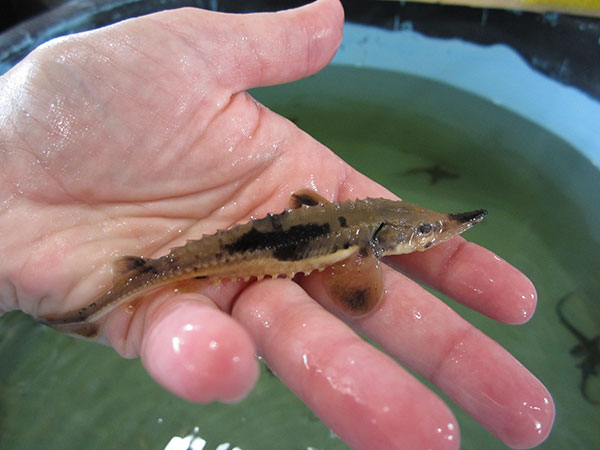MDNR Report
 Some 6,000 Stocked in Michigan Waters
Some 6,000 Stocked in Michigan Waters
The Michigan DNR and several partners released nearly 6,000 juvenile lake sturgeon into various public waters across the state this summer and fall in an effort to rehabilitate this culturally significant fish species.
The table below shows which agencies stocked fish, how many were stocked, and the date and location of each stocking effort.
| Agencies | Number of Stocked Fish | Date Stocked | Location Stocked |
|---|---|---|---|
| Michigan DNR & Michigan State University | 549 | Aug. 19 | Black Lake (Cheboygan County) |
| Michigan DNR & Michigan State University | 2261 | May 26 | Lower Black River (Cheboygan County) |
| Little Traverse Bay Band of Odawa Indians | 601 | Sept. 7 | Burt Lake/Sturgeon River (Cheboygan County) |
| Michigan DNR & Michigan State University | 740 | Sept. 19 | Mullet Lake (Cheboygan County) |
| Michigan DNR | 302 | Sept. 8 | Cedar River (Menominee County) |
| Michigan DNR, U.S. Fish & Wildlife Service, Gun Lake Tribe | 2 | July 25 | Kalamazoo River (Allegan County) |
| Michigan DNR | 72 | Sept. 11 | Whitefish River (Delta County) |
| Michigan DNR & U.S. Fish & Wildlife Service | 1261 | Sept. 19 | Ontonagon River (Ontonagon County) |
| Michigan DNR & Michigan State University | 193 | Aug. 21 | Tittabawassee River (Midland County) |
| Total Lake Sturgeon Stocked: | 5981 |
Juvenile lake sturgeon were collected from the wild during April and May and reared in streamside facilities until they were large enough to tag. Most fish were tagged prior to being released into their respective rivers to allow future evaluations of stocked fish.
"Many of these stocking efforts were public events that shined a spotlight on how important lake sturgeon are to Michigan," said DNR Fisheries Division Chief Jim Dexter. "Our state has a long history with the lake sturgeon, and working with our partners helps us protect them for future generations."
The lake sturgeon is on the Threatened Species list in Michigan, and these annual stocking efforts are critical to restoring the states lake sturgeon population. It takes the work of many partners to secure funding and resources to make restoration possible. Partners include the DNR, the Black Lake chapter of Sturgeon for Tomorrow, the Kalamazoo River chapter of Sturgeon for Tomorrow, the Little River Band of Ottawa Indians, the Little Traverse Bay Band of Odawa Indians, the Match-E-Be-Nash-She-Wish band of Pottawatomi Indians, the Keweenaw Bay Indian Community, Michigan State University, the U.S. Fish & Wildlife Service and the U.S. Forest Service.
For more information about lake sturgeon, visit www.michigan.gov/sturgeon.


